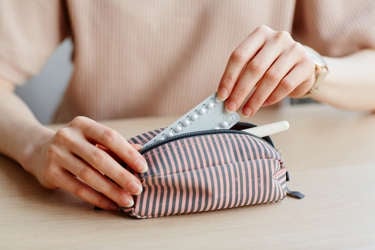What is a menstrual period?
A menstrual period is experienced by people with female reproductive body parts. It is the bleeding that occurs approximately once a month during the menstrual cycle when the lining of the uterus sheds. This bleeding is also called a “menses,” and you might also hear people talk about it using other nicknames and phrases like “Aunt Flo,” the “Time of the Month,” a person’s “Moon Time,” being on/having “Your days”, “Little Red Riding Hood is coming,” or the “Little strawberry.”
A cycle length is measured from the first day of bleeding (Day 1 of one menstrual period) to the first day of the next menstrual period. There is a wide range of normal cycle lengths. For teenagers, a normal menstrual cycle can be anywhere between 21-45 days. The average menstrual cycle length is approximately 28 days. In the first 1-2 years following your first period, it is very common and normal to have irregular cycles.
What is normal menstrual bleeding?
Just like menstrual cycle length, normal menstrual bleeding also varies in length.
Normal menstrual bleeding can last between 3-8 days. The amount of blood lost during this time can also vary. Usually, a normal range is 30-80 mL of blood. Because it is difficult to directly measure the amount of blood you are losing (unless using a menstrual cup), you can determine if you are having a normal period by knowing the number of menstrual products you use during your period.
Normal bleeding
- Soaking through up to 10-15 sanitary pads per cycle
- The pads are filled from side to side
- Soaking through up to 3-6 tampons per day during your period
Abnormal/heavy bleeding
- Soaking through and needing to change your menstrual products every 1-2 hours
- The tampons are soaked through
- The sanitary pads are filled from side to side and front to back
- Bleeding for longer than a week
- Passing blood clots larger than a quarter
Menstrual symptoms
There are a wide variety of symptoms that you might experience during your period, and they can range from very mild to significantly uncomfortable. These symptoms can change from cycle to cycle, and over time.
As well as during your period, it is also common to have symptoms in the week leading up to your period (premenstrual symptoms or PMS). Common symptoms include, but are not limited to:
- Abdominal cramping and discomfort
- Lower back pain
- Headaches
- Muscle aches
- Breast tenderness
- Changes in appetite
- Nausea
- Constipation
- Diarrhea
- Acne
- Mood changes
- Fatigue/low energy
These symptoms can occur in the week leading up to your period, and for up to 1-4 days after your period starts.
Managing your period
There are a variety of menstrual products that you can use to help manage menstrual bleeding. You may find that different products work better for you over time, on different days of your period, or depending on your comfort level, availability of products, and personal preference.
These products include sanitary pads, tampons, menstrual cups, and period underwear.

Sanitary pads
Sanitary pads range in thickness and absorption. They also come in disposable (single use) forms, or in reusable forms (which can be washed with detergent and reused). Disposable pads often have an adhesive backing or adhesive flaps, which can be applied to your underwear. Reusable pads usually have Velcro or snap button flaps to stay secure. Both types of pads should be changed every 4-6 hours. Reusable pads can be washed, but you should discard disposable pads after a single use.

Tampons
Like pads, tampons come in a variety of sizes and absorbability. Tampons have a string attached to help you remove them, and they can come with or without an applicator. Tampons are made of cotton or rayon and are inserted into the vagina to absorb menstrual blood. They must be changed every 4-6 hours and discarded after a single use. For more information, see Using your first tampon.

Menstrual cups
Menstrual cups come in a variety of sizes and can be disposable or reusable. They are cup-shaped, with a small “stem” to help you remove them. They are inserted into the vagina to collect menstrual blood. Cups should be removed and emptied every 8-12 hours. Disposable cups should be discarded after a single use.

Period underwear
Period underwear is underwear designed to absorb menstrual blood without the need for other menstrual products. They are best for times of light bleeding and can be used in combination with other menstrual products during heavier flow. Period underwear looks and feels like regular underwear and is reusable with regular washing. It can be worn all day for up to 24 hours, depending on your flow.
When to see a doctor
It is recommended you talk to your doctor if:
- Your menstrual period started early (before the age of nine).
- Your menstrual period has not started by the age of 15, or it has not started and it has been over two years since you started puberty (since your breasts started developing).
- You are experiencing heavy menstrual bleeding (changing menstrual products every 1-2 hours because they are completely soaked through).
- You are consistently bleeding for more than seven days.
- You are noticing significant symptoms (e.g., pain) around the time of your menstrual period that are impacting your ability to participate in school or other daily activities, or symptoms that occur throughout your cycle.
- Your menstrual period has stopped.







